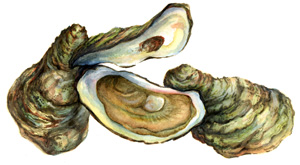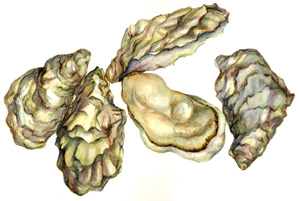Farmed Oysters


Credit: Brenda Guild
Names:
American or Eastern Oyster (Crassostrea virginica), Pacific Oyster (Crassostrea gigas)
Locations:
British Columbia, New Brunswick, Nova Scotia, Prince Edward Island and Quebec
Methods:
Ocean floor beds or off-floor suspension (holding bags, cages, trays or rope lines)
At a Glance
Farmed oysters are Canada’s second most valuable shellfish aquaculture species, after mussels. They are the third most important species raised in Canada in terms of volume. British Columbia is the leading oyster producing province in Canada.
Value
The annual average farm-gate value of oyster culture in Canada was $11.7 million in the last five years (2011-2015). British Columbia oyster culture production represents almost 45% of this total while Prince Edward Island represents just over 30% and New-Brunswick around 20%. Farm-gate value represents a product’s value once it is sold by the producer.
Production
An annual average of 25,800 tonnes of oysters was produced in the last five years (2011-2015). British Columbia produced 60% of that quantity.
The Pacific Oyster is the most widely cultured oyster in the world. Introduced from Japan specifically for aquaculture in Canada, this shellfish species is farmed only in British Columbia; primarily in the Strait of Georgia and on the west coast of Vancouver Island. Principal markets for British Columbia oysters are the United States, Singapore, and Hong Kong.
American Oysters are grown in the warm, shallow bays and estuaries of the southwestern Gulf of St. Lawrence along the coast of Prince Edward Island and New Brunswick, as well as in the coves of Cape Breton’s Bras d’Or Lakes. Water temperatures in other coastal areas are generally too cold for the natural reproduction and suitable growth of these oysters. Two types of American Oyster are produced in Atlantic Canada: the traditional-size oyster (between 7.6 and 12.7 cm or 3 to 5 inches); and the “cocktail” oyster (less than 7.6 cm or 3 inches).
Oyster farmers need a reliable source of seed or spat. Producers in Atlantic Canada have been using “spat collectors” since the 1950s to culture seed, while British Columbia oyster growers mainly purchase seed from hatcheries. When the oysters are ready for grow-out, they are spread onto beaches or placed in suspension culture systems. Suspension systems can be floating rafts, floating bags, bags in cages, trays, or bags on racks or tables. Held in suspension, oysters grow more rapidly and develop plumper meats because the water circulation increases the availability of food.
For more information on aquaculture’s impact, consult Aquaculture statistics and reports:
Regulations
Fisheries and Oceans Canada is responsible for oyster lease applications in Prince Edward Island. In New Brunswick and Nova Scotia, provincial regulations and legislation guide the administration of aquaculture site leases, licences, and permits. Specific allowed periods of collection, which differ from one location to the other, are indicated on the spat collection licence.
Licences to cultivate Pacific oysters in British Columbia are administered by Fisheries and Oceans Canada as authorized through the Pacific Aquaculture Regulations. In British Columbia, provincial legislation guides the administration of aquaculture site tenures.
Scientific Research
Scientific research informs the development of, and decisions related to, aquaculture regulations in Canada. This includes regulations related to the cultivation sites for American and Pacific oysters. Scientific studies have been undertaken to: improve production technologies and practices; mitigate the effects of cultivation gear on the marine ecosystem; and better understand diseases that might affect farmed oysters.
- Date modified: